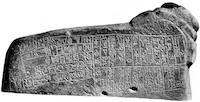- Introduction
- Further information

Linear Elamite is attested in Susa, Shahdad, Marv Dasht and Konar Sandal. How this writing system relates to Proto-Elamite is still a matter of debate. It appeared centuries after the disappearance of the Proto-Elamite. According to François Desset, the scholar who deciphered this writing, Linear Elamite was created in a completely autonomous way with respect to the cuneiform, the Mesopotamian writing system that was widespread in the Near East, including the Elamic region. Of the Linear Elamite inscriptions known today, about forty, most come from Susa. Linear Elamite appears to have been in use in southern Iran between 2500/2400 and 1900/1800 BC, preferably for royal inscriptions on stone and silver vessels. Despite the high number of graphic variants, Linear Elamite appears to be made up of about a hundred signs. This phonetic type of writing could be read from right to left and from top to bottom. Along with this linear writing, a geometric script was also in use, as evidenced by some clay tablets of the second half of the third millennium BC from Konar Sandal. This writing, still undeciphered, included 254/256 signs, of which the most frequent were in the form of squares, circles and triangles. It is interesting to note that some of these tablets from Konar Sandal are bigraphical, since they use both Linear Elamite and geometric writing in the same text.
Go to the online resources.
Online resourcesPhoto Gallery
Bibliography
Map of places
